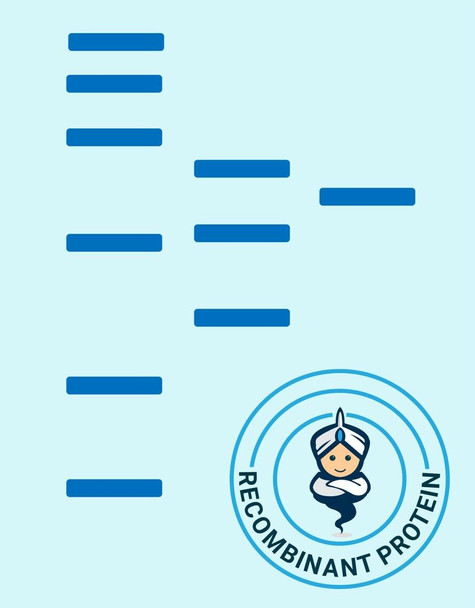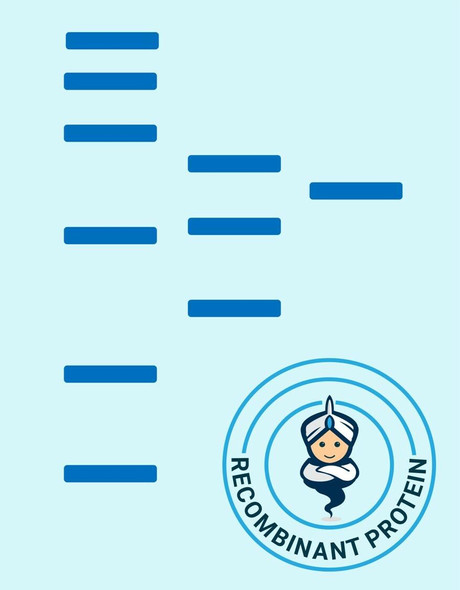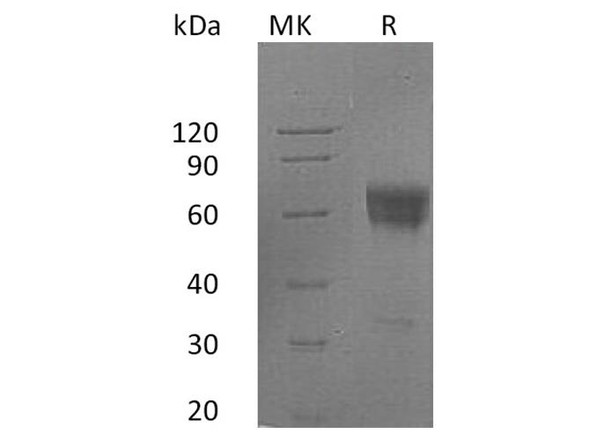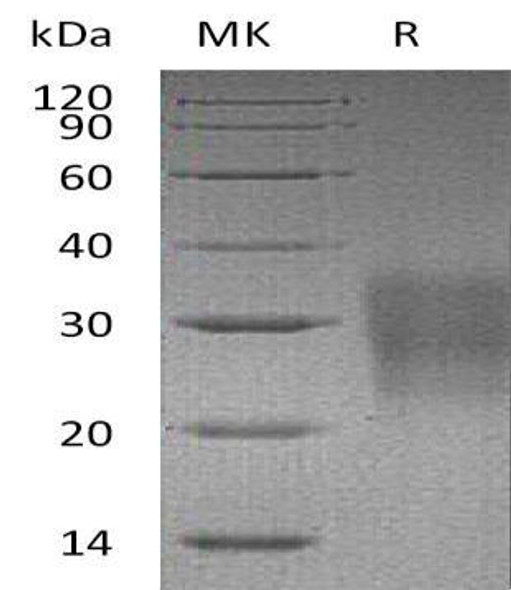Description
| Product Name: | Human FAS Recombinant Protein |
| Product Code: | RPPB0195 |
| Size: | 20µg |
| Species: | Human |
| Target: | FAS |
| Synonyms: | CD95, CD-95, Tumor necrosis factor receptor superfamily member 6, FASLG receptor, Apoptosis-mediating surface antigen FAS, Apo-1 antigen, CD95 antigen, FAS, APT1, FAS1, TNFRSF6, APO-1, FASTM, ALPS1A. |
| Source: | Escherichia Coli |
| Physical Appearance: | Sterile liquid formulation. |
| Formulation: | 10mM Sodium Phosphate, pH 8.0. |
| Stability: | CD95 although stable at 10°C for 5 days, should be stored below -18°C.Please prevent freeze-thaw cycles. |
| Purity: | Greater than 95% as determined by:(a) Analysis by RP-HPLC.(b) Analysis by SDS-PAGE. |
FAS / CD95 is a 36kDa transmembrane type I receptor, which belongs to the NF/NGF receptor super-family. It is a potent inducer of apoptosis in cells of the immune system upon interaction with its natural ligand, CD95L. Although the CD95/CD95L system could play a role in tumor regression, tumor cells seem to down-regulate CD95 expression as a mechanism of resistance to CD95L-induced killing by T lymphocytes and NK cells. The Fas antigen is expressed on the surface of various cell types, including activated T and B lymphocytes and T lymphoblastoid cell line. CD95 is also expressed in a broad panel of non-transformed cells outside the immune system.
Recombinant FAS antigen/ CD95 purified from E. coli is a single non-glycosilated polypeptide chain containing amino acids 157-335 of Fas antigen. The recombinant CD95 is fused to C-terminal 6-histidine amino acids. The FAS antigen is purified by proprietary chromatographic techniques.
| UniProt Protein Function: | FAS: Receptor for TNFSF6/FASLG. The adapter molecule FADD recruits caspase-8 to the activated receptor. The resulting death- inducing signaling complex (DISC) performs caspase-8 proteolytic activation which initiates the subsequent cascade of caspases (aspartate-specific cysteine proteases) mediating apoptosis. FAS- mediated apoptosis may have a role in the induction of peripheral tolerance, in the antigen-stimulated suicide of mature T-cells, or both. The secreted isoforms 2 to 6 block apoptosis (in vitro). Binds DAXX. Interacts with HIPK3. Part of a complex containing HIPK3 and FADD. Binds RIPK1 and FAIM2. Interacts with BRE and FEM1B. Interacts with FADD. Isoform 1 and isoform 6 are expressed at equal levels in resting peripheral blood mononuclear cells. After activation there is an increase in isoform 1 and decrease in the levels of isoform 6. 6 isoforms of the human protein are produced by alternative splicing. |
| UniProt Protein Details: | Protein type:Apoptosis; Membrane protein, integral; Receptor, cytokine; Cell surface Chromosomal Location of Human Ortholog: 10q24.1 Cellular Component: cell surface; cytoplasm; plasma membrane; integral to membrane; CD95 death-inducing signaling complex; nucleus; cytosol; lipid raft; external side of plasma membrane Molecular Function:identical protein binding; protein binding; signal transducer activity; transmembrane receptor activity; receptor activity; kinase binding Biological Process: circadian rhythm; caspase activation; spleen development; regulation of myeloid cell differentiation; renal system process; transformed cell apoptosis; apoptosis; positive regulation of apoptosis; positive regulation of protein homooligomerization; regulation of lymphocyte differentiation; response to toxin; response to glucocorticoid stimulus; negative regulation of B cell activation; signal transduction; negative thymic T cell selection; regulation of apoptosis; inflammatory cell apoptosis; B cell mediated immunity; induction of apoptosis via death domain receptors; gene expression; protein complex assembly; immunoglobulin production; activated T cell apoptosis; protein homooligomerization; negative regulation of apoptosis Disease: Autoimmune Lymphoproliferative Syndrome |
| NCBI Summary: | The protein encoded by this gene is a member of the TNF-receptor superfamily. This receptor contains a death domain. It has been shown to play a central role in the physiological regulation of programmed cell death, and has been implicated in the pathogenesis of various malignancies and diseases of the immune system. The interaction of this receptor with its ligand allows the formation of a death-inducing signaling complex that includes Fas-associated death domain protein (FADD), caspase 8, and caspase 10. The autoproteolytic processing of the caspases in the complex triggers a downstream caspase cascade, and leads to apoptosis. This receptor has been also shown to activate NF-kappaB, MAPK3/ERK1, and MAPK8/JNK, and is found to be involved in transducing the proliferating signals in normal diploid fibroblast and T cells. Several alternatively spliced transcript variants have been described, some of which are candidates for nonsense-mediated mRNA decay (NMD). The isoforms lacking the transmembrane domain may negatively regulate the apoptosis mediated by the full length isoform. [provided by RefSeq, Mar 2011] |
| UniProt Code: | P25445 |
| NCBI GenInfo Identifier: | 119833 |
| NCBI Gene ID: | 355 |
| NCBI Accession: | P25445.1 |
| UniProt Secondary Accession: | P25445,Q14292, Q14293, Q14294, Q14295, Q16652, Q5T9P1 Q5T9P2, Q5T9P3, Q6SSE9, A9UJX4, B6VNV4, |
| UniProt Related Accession: | P25445 |
| Molecular Weight: | 37,732 Da |
| NCBI Full Name: | Tumor necrosis factor receptor superfamily member 6 |
| NCBI Synonym Full Names: | Fas cell surface death receptor |
| NCBI Official Symbol: | FAS�� |
| NCBI Official Synonym Symbols: | APT1; CD95; FAS1; APO-1; FASTM; ALPS1A; TNFRSF6�� |
| NCBI Protein Information: | tumor necrosis factor receptor superfamily member 6; Fas AMA; FAS 827dupA; CD95 antigen; FASLG receptor; apoptosis antigen 1; Delta Fas/APO-1/CD95; FAS receptor variant 9; APO-1 cell surface antigen; TNF receptor superfamily member 6; apoptosis-mediating surface antigen FAS; Fas (TNF receptor superfamily, member 6); tumor necrosis factor receptor superfamily, member 6 |
| UniProt Protein Name: | Tumor necrosis factor receptor superfamily member 6 |
| UniProt Synonym Protein Names: | Apo-1 antigen; Apoptosis-mediating surface antigen FAS; FASLG receptor |
| Protein Family: | Development-specific protein |
| UniProt Gene Name: | FAS�� |
| UniProt Entry Name: | TNR6_HUMAN |










